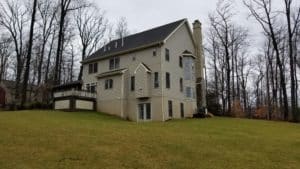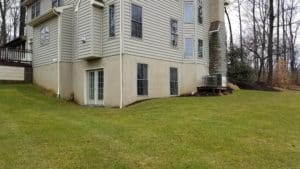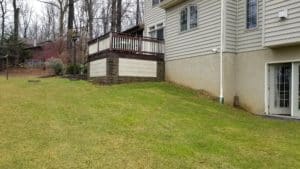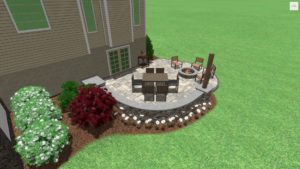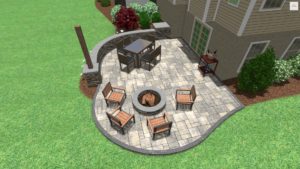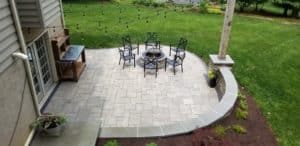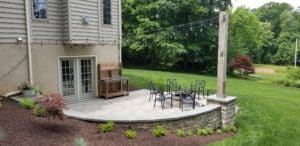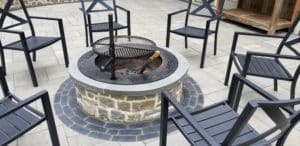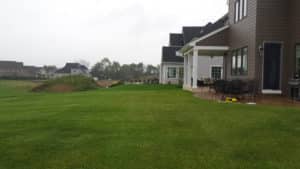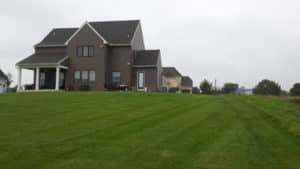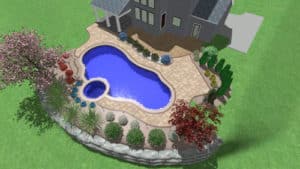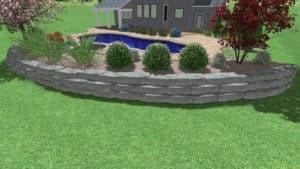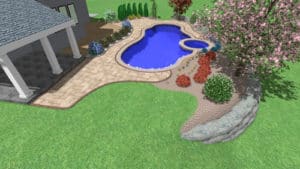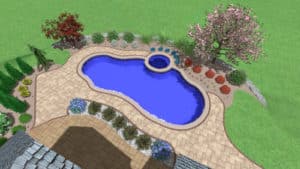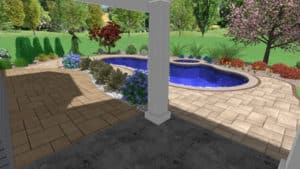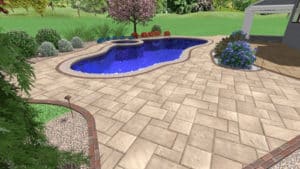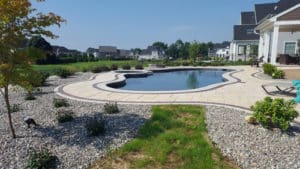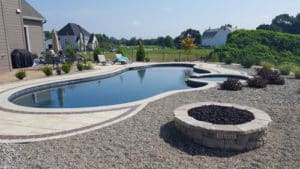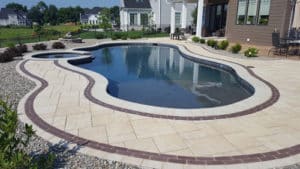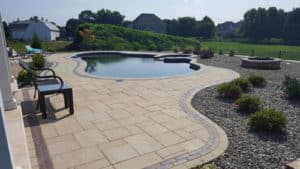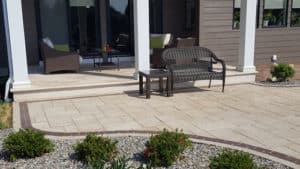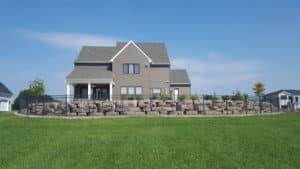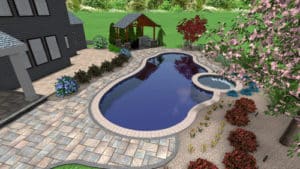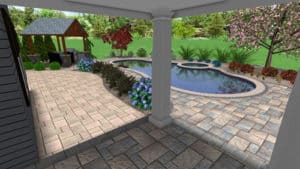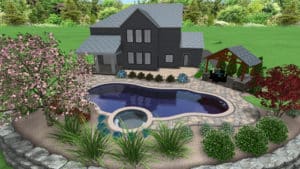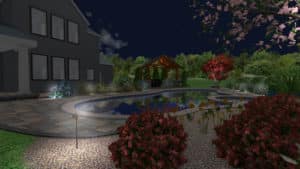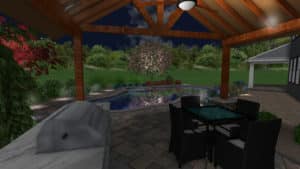Blog
Scroll
Blog
Help your house stand out – no spring cleaning or paint required!
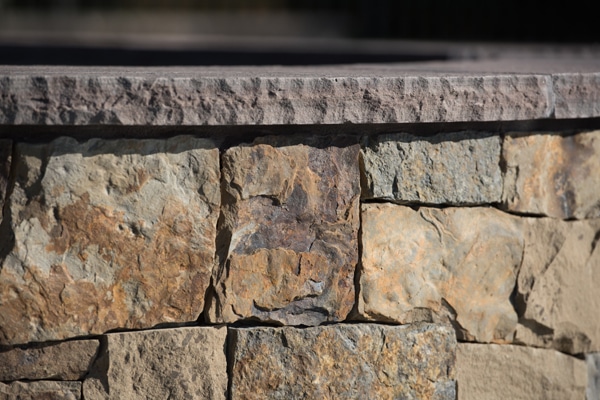
Spring flowers are blooming. Why shouldn’t your house bloom too? Are you ready to give your home that extra, eye-catching “pop” you’ve been dreaming about all winter?
The experts at Knutsen Landscaping can help! There are a few ways that you can make your house stand out – don’t worry, it doesn’t involve a new coat of paint or any spring cleaning! In fact, it all starts in the yard.
- Add a pergola! Pergolas are often viewed as an extension of the home itself and they are open and airy – a fresh alternative to a standard gazebo. Add a table and some comfy chairs beneath the dappled spring sunlight overhead, and you will have a relaxing and chic environment to host your warm weather get-togethers!
- Freshen up the flowers! It may be time to add some vibrant colors to the gardens. Let Knutsen Landscaping plant lush shrubs, trees, and perennial flowers in your garden beds, and prepare to enjoy all the sights and smells of spring!
- Have a retaining wall built! Retaining walls are certainly functional, but they are becoming increasingly elaborate and stylish. These walls can provide privacy for your family while enjoying an evening in the backyard, and add an aesthetic dimension to your lawn.
- Have landscaping lighting installed! Landscape lighting can add the perfect ambience to your outdoor entertaining or lounge space. Not only does this lighting provide a soft glow for those evening hours in the yard, but they can help illuminate your home as well.
There are several ways to spruce up your house for spring by focusing on the lawn! Let the experts at Knutsen Landscaping help you decide how to make your yard bloom!
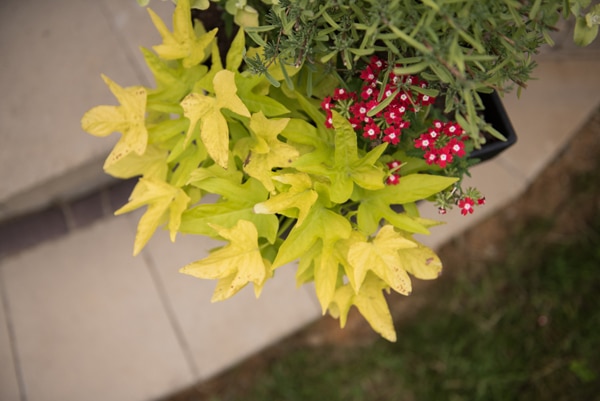
Hardscaping Adds Value to Your Home
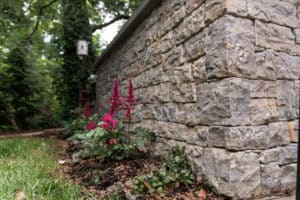
At long last, warmer weather has made an appearance, drawing us outdoors and into our long-neglected lawns. It is time to freshen up the yard in preparation for summer, but where to start? Is it possible to increase the value, comfort, and visual appeal of our homes with just a simple addition?
The experts at Knutsen Landscaping say “of course.” Investing in hardscaping is a win-win situation for homeowners for a few reasons.
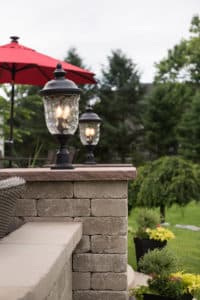
Whether you’re considering selling your house, or you’re committed to staying put for years, hardscaping can increase the curb appeal of your home. The exterior of your home and your lawn provide potential buyers or visitors with their first impression of the interior. A blend of different colors and textures can catch the eye of even the most distracted passerby.
Hardscaping also makes unusable space usable, in creative and convenient ways. Is there a steep hill in your backyard? Is that sunny patch of grass perfect for a lawn chair, except for the poor drainage every time it rains? Hardscapes can solve those yard woes.
Speaking of poor drainage, if every storm creates a headache for you due to grade changes and erosion, retaining walls are a form of hardscapes that can drastically reduce this. By redirecting the flow of water, retaining walls can rescue a house’s foundation, or eliminate unsightly mud puddles.
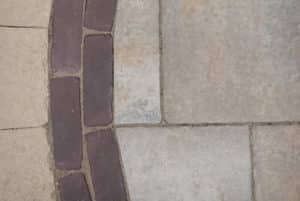
Hardscapes also provide privacy, and more importantly, safety for you and your family. The experts at Knutsen Landscaping can help you decide the best location and design for your hardscape, for ultimate functionality and visual appeal.
Whether you’re dreaming of relaxing beneath a new pergola, admiring an ornate retaining wall in your garden, or sweeping off a pristine patio, hardscaping is a positive, rewarding way to increase the beauty and individuality of your home.
Project Showcase: Manheim Township Pool
A Strong Paver Foundation
As spring approaches and you begin pondering which outdoor projects to move to the top of your to-do list, consider laying a lasting foundation for your eye-catching patio, garden walkway or driveway that will add both beauty and value to your home for years to come.
Knutsen Landscaping has long believed in the performance benefits of permeable open graded stone installations for these projects.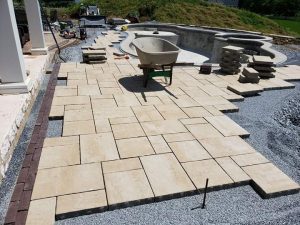
“It has taken the rest of the industry a while to come around. We have been laying patios in this fashion for many years, and the experience we have gained shows in our final product,” says Andy Knutsen, president.
Knutsen Landscaping is currently participating in a study with the Interlocking Concrete Pavement Institute to demonstrate the durability that open grade paver installations provide. Studies are showing that more commercial developers are choosing to use a permeable base model for all installations. The size and thickness of these permeable bases can vary and is determined by traffic loads, soil strength, subgrade soil drainage, moisture and climate, making them much more adaptable and economical.
Pavers have a rustic beauty that come in a vast array of shapes, patterns, colors and textures and are more visually appealing than concrete slabs. By replacing your cement driveway, old walkway or concrete patio with permeable pavers over an open grade stone foundation, you are not only building something that will last generations, you are also increasing the value of your home while improving the environment that surrounds it.
An open graded stone foundation also promotes the natural water cycle. With open graded stone, drainage disperses evenly throughout the patio or walkway area in a much more natural fashion. Proper filtration can reduce pollution density and foster the overall health of your home’s environment. It will also help to prevent the damage to your property caused by erosion. Especially with the freeze-thaw cycles here in the northeast, your patio will be unaffected by these changes in conditions over time.
Feel free to call or email us about building a patio or walkway or refinishing a driveway using pavers with a permeable base. We will be happy to work alongside you to make any outdoor project one that lasts a lifetime.
Winter Planning
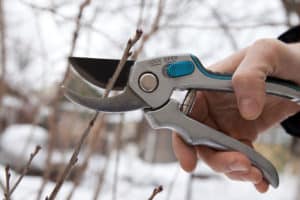
As we gear up for winter weather, many with gardening in their souls assume that there is nothing to do but wait until the buds begin to pop and that first robin announces the end of the long, bleak season. But as author and naturalist Hal Borland said, “No winter lasts forever; no spring skips its turn.”
Even though the calendar page has turned, there is plenty that we can do to prepare for the coming of spring. In fact, winter is the perfect time to start planning your spring projects. You will find, especially if you have any ambitious projects in mind, that there are municipal hurdles to jump through before making those modifications. You will probably find better pricing during the colder months, and scheduling your spring projects now will offer a much wider window of choices. In addition, you will likely discover a wider selection of materials before the spring scheduling rush begins. Of course, a key benefit to planning projects now is the time to determine your budget and to marshal your resources, just like a squirrel gathering nuts—just don’t forget where they are!
Usually we have more time for sitting down and planning in the winter, so take advantage of that. Settle down with some hot cocoa and visualize your spring projects! And if you need incentive for this forward-thinking, keep in mind that waiting until later may mean waiting until March or April to schedule the project, and the implementation of it might have to wait until summer or fall.
In the meantime, here are just a few winter maintenance chores that you can tackle now for your trees and shrubs:
- Apply mulch
- Prune while plants are dormant
- Apply wire mesh at the base of young trees to protect against gnawing wildlife
- Tie branches together and remove limbs likely to break in order to safeguard against ice and snow.
So there’s plenty of gardening to do, even in the bleak midwinter!
Your First Choice for Fire Pits
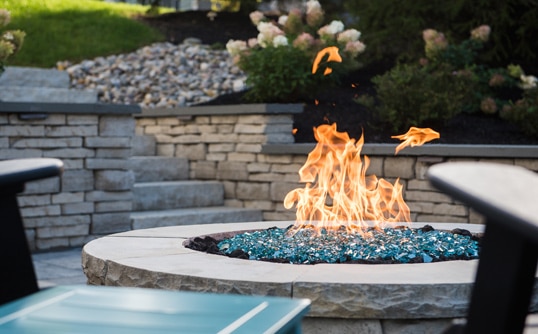
Neither is better than the other; they each have pros and cons. So let’s take a look at six factors, and you can decide which works better for you.
- Fuel availability. If you live in rural area with plenty of firewood nearby, wood is obviously an easy option. Or if you are in a suburban home, there may already be a gas line in place. If you already have natural gas or propane appliances, it could be a very practical expense to add an outdoor fire feature as you wouldn’t have to worry about running service from the road or purchasing a tank for propane.
- Installation price and time. Wood is certainly less expensive than gas. Also, wood-burning fire pits are less costly to install and can typically be built in 50 – 75 percent of the time needed to install a gas-burning unit.
- Fuel storage. A propane-burning fire pit will require a storage tank that would hold from 15 to 100 gallons, depending on how often you use it. Firewood also requires storage space, so you’d need to consider where to stack it without detracting from the appearance of your home. Don’t stack it against the house, however, as firewood may harbor termites.
- Convenience. Gas is the hands-down winner here. It’s obviously easier to push a button and have an instant fire. You also would not have to deal with the mess of the firewood and ash cleanup.
- Safety. There is always a danger of leaks with gas. But if the fire pit is professionally installed, these are rare. With wood, there are of course dangers inherent in cutting the wood, stacking it properly, and dealing with the fire when you are finished. In either case, understanding the risks and knowing how to handle fire responsibly are very important to your enjoyment of an outdoor fire feature. If you have children around the fire, make sure to teach them fire responsibility as well.
- Primary use. If you just want the ambience and heat of a fire, gas is certainly an easy option. But if you want to cook on the fire, you need to go with wood. Knutsen Landscaping offers the Zentro smokeless fire pit from Breeo, with a special design to keep the smoke to a barely noticeable trace. And a special swing-away grilling rack works wonderfully with these fire pits.
With all these considerations, the choice is up to you. And the professionals at Knutsen Landscaping will be happy to assist you no matter which one you choose. Either way, a fire pit is a great way to enjoy the outdoors even in the coldest weather. You can have your own winter wonderland for many years to come!
Future Proofing Your Landscaping
For many people, working in the yard is an enjoyable and relaxing way to make the most of your property and lovely weather. But there comes a point – especially as we grow older – where lawn maintenance becomes too much. You won’t always be able or willing to spend an entire Saturday weeding your property, for example! Here are five tips for reducing or eliminating some of the basic lawn work:

Many people cut their grass too short, which weakens it and allows more weeds to grow. It also means you’re mowing more than you have to. Each type of grass has an ideal mowing height, so call Knutsen Landscaping to inquire about your specific grass. Generally, it ranges from 1 ½ to 2 ½ inches.
Mulch trees
Trimming around trees it not only time consuming, but you can also easily nick the bark, which can fatally damage young trees. You can avoid trimming around your trees by applying a 2- to 4-inch deep ring of mulch around trees and shrubs. (If your soil doesn’t drain well, you probably want it no more than 2 inches deep.) Be careful to keep the mulch about 3 inches away from the trunk itself to prevent disease, root suffocation and other problems.
Fertilize just in the fall
Skip spring fertilizing and do it only in the fall. It will provide nutrients for fall root growth and a shot of energy the following spring. Knutsen Landscaping can recommend the best fertilizer for your type of grass and soil conditions. Apply the fertilizer about three weeks before the last mowing of the season. This provides energy and nutrients for the grass roots as they multiply in the cooler fall weather while also giving them a head start the following spring.
Build paths that you can mow over
Stone or paver paths that follow the topography of your yard can let you mow without additional trimming. Paths conforming to your landscape require less upkeep than the more formal paths that include steps, walls and curbs. The key is to set the stones or pavers no higher than an inch above ground level. Then you can mow right over them and skip the extra trimming. Not only are these easy to maintain, they are can also be very affordable paths.
Install mowing borders
Keep grass from growing along flower beds, walls, fences and other obstacles where your mower can’t easily reach by installing a mowing border. This will allow you to run your mowers over them to cut your grass without the need for separate trimming. If you set the border an inch above the ground and make it 4 inches deep, you will prevent grass from creeping over and through it.
These are just a few tips that can relieve the amount of work required to maintain your yard. Contact Knutsen Landscaping for more ways to cut down on the work and free yourself up for a simpler maintenance routine of your property!
Hardscape Impact
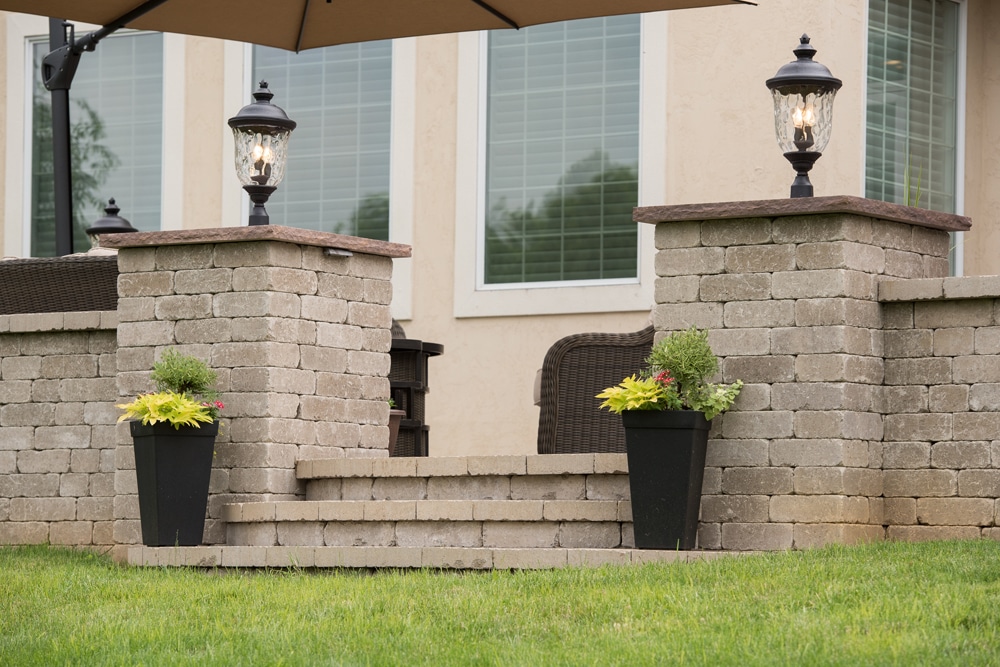
There are four basic benefits that hardscaping brings to your home:
Safety and Privacy
Seat walls provide privacy and protection against the elements, and landscape lighting along paver walkways and patios, or under retaining wall caps, offers night time ambiance and functionality.
Preventing Erosion
Retaining wall systems are essential in preventing the damage to your property as well as the major headaches caused by erosion. In some cases, these can escalate to damaging your home. For instance, a yard that slopes steeply toward your home’s foundation is an easy way for water damage to become an issue. A well-designed and installed retaining wall system can create a positive flow away from the foundation, while also creating usable steps or space for flower beds and seating.
Making Unusable Space Usable
Depending where your home is situated, you may have sloping hills that are difficult to maintain and that offer no usable space. These areas are prime candidates for retaining walls, seat walls, flower beds, or foundations that could accommodate a pergola or other structure. Why not optimize the usefulness of every area of your property?
Curb Appeal
Most real estate agents will agree that your home’s first impression is paramount when preparing it for sale. Retaining walls and paver stone edging around gardens are simple updates that dramatically add value and curb appeal. For even greater impact, consider more ambitious projects like a front paver stone entrance with a patio and a seat wall or two.
For most homeowners, there is immediate and lasting value to be gained from adding hardscaping to your outdoor living space. Contact the design professionals at Knutsen Landscaping to determine the best options for your property, and see the impact for yourself!
Winner of Unilock Award of Excellence


